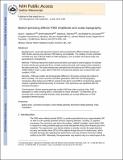| dc.contributor.author | Salisbury, Dean F | |
| dc.contributor.author | Rutherford, Bret | |
| dc.contributor.author | Shenton, Martha Elizabeth | |
| dc.contributor.author | McCarley, Robert William | |
| dc.date.accessioned | 2016-09-15T19:32:08Z | |
| dc.date.issued | 2001 | |
| dc.identifier.citation | Salisbury, Dean F, Bret Rutherford, Martha E Shenton, and Robert W McCarley. 2001. “Button-Pressing Affects P300 Amplitude and Scalp Topography.” Clinical Neurophysiology 112 (9) (September): 1676–1684. doi:10.1016/s1388-2457(01)00607-1. | en_US |
| dc.identifier.issn | 1388-2457 | en_US |
| dc.identifier.uri | http://nrs.harvard.edu/urn-3:HUL.InstRepos:28520167 | |
| dc.description.abstract | Background: Scant and equivocal research exists examining the effects of button-pressing on P300. Button-pressing may decrease P300 latency and amplitude. The melding of motor potentials and P300 may also confound studies of P300 topography, such as studies of temporal scalp-area asymmetries in schizophrenia. Method: P300 was measured on button-press and silent-count tasks in control subjects. An estimate of motor activity was constructed from a simple reaction time task, with reaction times matched to the button-press task. The motor estimate was subtracted from the button-press P300 to assess Kok’s (1988) additive model. Lastly, lateral P300 from schizophrenia patients was compared with each condition’s P300. Results: P300 was smaller and its topography different in the button-pressing task relative to silent-counting. The motor-correction procedure generated a P300 with normal topography. Comparison of the button-press P300 in controls to the silent-count P300 in schizophrenia patients reduced a significant lateral asymmetry to trend level. This asymmetry was significant after the correction procedure. Conclusions: Button-pressing generates smaller P300 than silent-counting. Also, P300 topography in button-pressing tasks is confounded by motor potentials. The distortion can be corrected with a motor potential estimate. Motor potentials can occlude differences in P300 topography between groups. | en_US |
| dc.language.iso | en_US | en_US |
| dc.publisher | Elsevier BV | en_US |
| dc.relation.isversionof | doi:10.1016/s1388-2457(01)00607-1 | en_US |
| dc.relation.hasversion | https://www.ncbi.nlm.nih.gov/pmc/articles/PMC2650488/ | en_US |
| dash.license | LAA | |
| dc.subject | button-press | en_US |
| dc.subject | correction procedure | en_US |
| dc.subject | event-related potentials | en_US |
| dc.subject | movement-related potential | en_US |
| dc.subject | P300 | en_US |
| dc.subject | topography | en_US |
| dc.title | Button-pressing affects P300 amplitude and scalp topography | en_US |
| dc.type | Journal Article | en_US |
| dc.description.version | Accepted Manuscript | en_US |
| dc.relation.journal | Clinical Neurophysiology | en_US |
| dash.depositing.author | Shenton, Martha Elizabeth | |
| dc.date.available | 2016-09-15T19:32:08Z | |
| dc.identifier.doi | 10.1016/s1388-2457(01)00607-1 | * |
| dash.identifier.orcid | 0000-0003-4235-7879 | en_US |
| dash.contributor.affiliated | Shenton, Martha | |
| dash.contributor.affiliated | McCarley, Robert William | |
| dc.identifier.orcid | 0000-0001-5705-7495 | |


